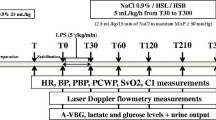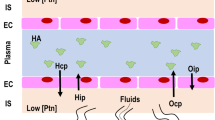Summary
A hyperdynamic circulatory state is the characteristic feature of septic shock in its early phase. Survival may be increased if the transition of the high flow state into the hypodynamic, low flow state can be prevented by well-controlled volume support using pulmonary capillary wedge pressure as a readily available clinical guideline. In our animal study the maintenance of cardiac output in endotoxaemia prevented the development of low flow/high resistance shock. The lungs ventilatory function was only moderately affected with no significant difference between volume substitution with either dextran 60 or Ringer’s lactate. However, we found that vital organs suffer microcirculatory disturbances early in the initial phase of endotoxaemia. Impairment of regional and intra-organ blood flow distribution was more pronounced in the animals treated with Ringer’s lactate. Dextran 60 appeared to prevent underperfusion of vital organs by maintaining vascular volume at a constant colloid osmotic pressure; no signs of tissue overhydration were observed.
Similar content being viewed by others
References
Villazon SA, et al. Hemodynamic patterns in shock and critically ill patients. Crit Care Med 1975; 3: 215–21.
Messmer K. Pathophysiologie des septischen Patienten. Intensivmed Notfallmed Anaesthesiol 1982;37: 12–26.
Messmer K: Septic shock: pathophysiology and clinical features. Intensivmed Notfallmed Anaesthesiol 1985;52: 2–3.
Pine RW, et al. Determinants of organ malfunction or death in patients with intra-abdominal sepsis. Arch Surg 1982; 118: 242–49.
Waisbren BA. A paradigm that explains gram-negative shock. Am J Med 1978; 65: 403–5.
Siegel JH, et al. Abnormal vascular tone, defective oxygen transport and myocardial failure in human septic shock. Ann Surg 1967; 165: 504–17.
Shoemaker WC. Cardiorespiratory patterns in complicated and uncomplicated septic shock. Ann Surg 1971;174: 119–25.
Clowes GHA, et al. Energy metabolism in sepsis. Ann Surg 1974; 179: 684–96.
Gunnar RM, et al. Hemodynamic measurements in bacteremia and septic shock in man. J Infect Dis 1973; 128: 5295–98.
Houtchens BA, Westenskow DR. Oxygen consumption in septic shock: collective review. Circ Shock 1984;13: 361–84.
Sturm JA, et al. Albumin extravasation as a method of following pulmonary permeability changes in multiple-trauma patients. Langenbecks Arch 1985 (Suppl): 69–73.
Robin ED, et al. Capillary leak syndrome with pulmonary edema. Arch Intern Med 1972;130: 66–72.
Carroll GD, Snyder JV. Hyperdynamic severe intravascular sepsis depends on fluid administration in cynomolgus monkey. Am J Physiol 1982;243: R l3l-41.
Author information
Authors and Affiliations
Rights and permissions
About this article
Cite this article
Zhen, Y., Kreimeier, U. & Messmer, K. The role of fluid replacement in acute endotoxin shock. Journal of Tongji Medical University 8, 74–77 (1988). https://doi.org/10.1007/BF02887797
Issue Date:
DOI: https://doi.org/10.1007/BF02887797




